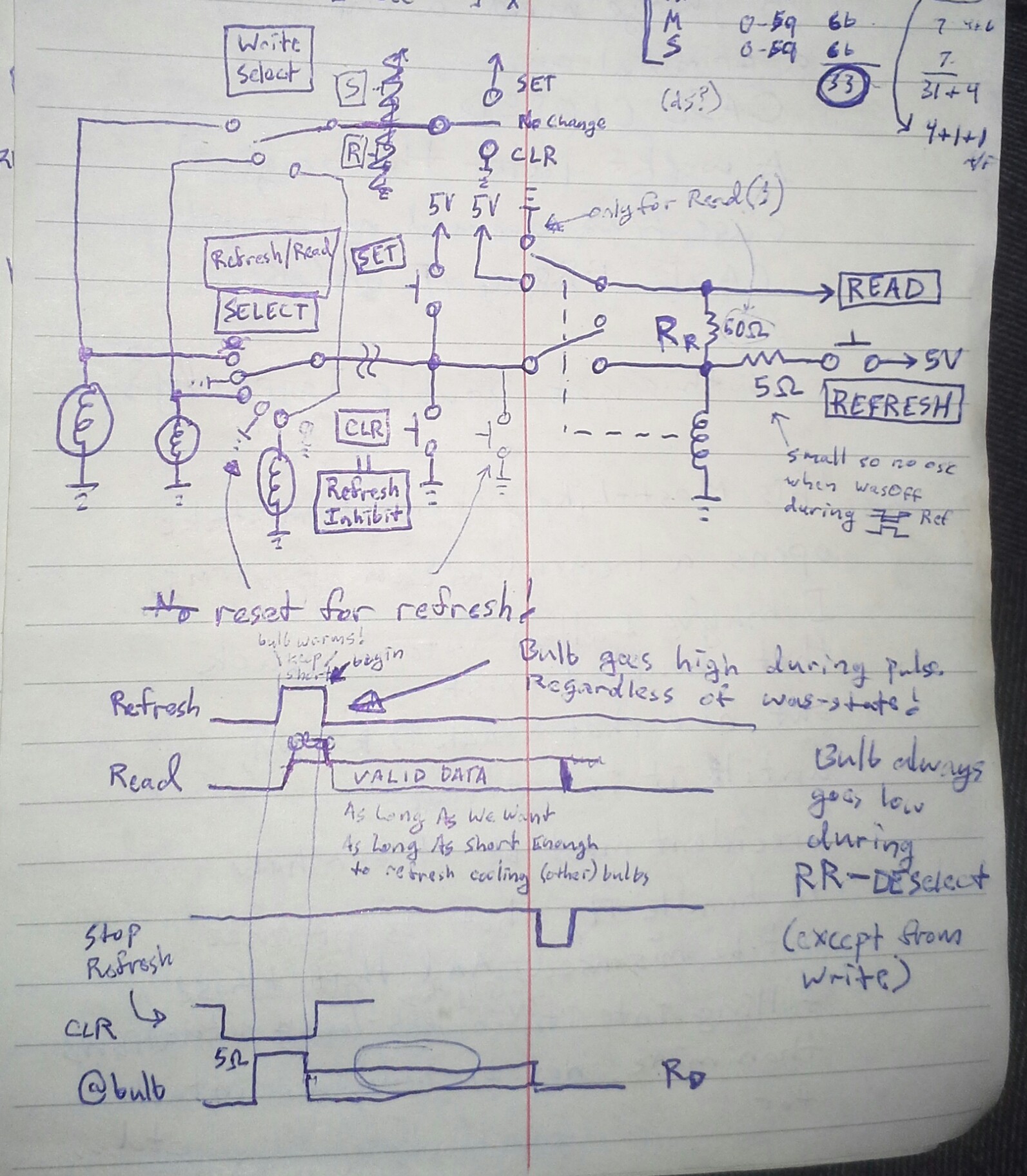
Heh, thought about drawing it again [again again] cleaner, but there's a lotta info here.
It may be hard to tell, but the idea is to use just one read/write/refresh circuit for numerous bulbs (maybe a row). The Refresh-Select switch is likely to be a motorized-drum with magnets and reed switches. This might also handle timing for the Refresh and Refresh-Inhibit/Stop pulses, as well as another pulse during Data-Valid.
Write-select is on a different switch [rotary, likely motorized]. Note that writing safely overrides refresh on the selected bulb, and presently does so as fast as possible... Not requiring the multiplexed refresh circuit to do-so, nor interfering with refresh timing of other bulbs.
(oh snap, 'safely' was before the refresh-reset ... gotta look into that. TODO)
Relays, then, can also be used in the write circuitry, for automation...
Oh, snap... I just came up with another possible change.
Anyhow, was-thinking a 5x7 display might be manageable...
This, of course, all relies on whether bulbs can be found near these specs...
100ohms 5V -> 50mA? Sure... and 1K relay-windings? Seems doable. Induction, heating/cooling-time, thermocouples(?!)... I guess we'll see.
But I've obviously gotten carried-away, already thinking of 5x7, write-complete feedback, counters, and even ISA cards...
How about *one*, hand-controlled light-bit, first.
Might be a while. Might be repurposing a relay or two from under the hood!
Oh, and resistors... these values aren't in my collection, and I'm a ways away from the part-store... I might just scrap some pencils.
(Which, dangit, woulda been *the* solution for the friggin' battery charger!)
Oh yeah, hey... the read-process inherently refreshes and vice-versa... kinda handy.
 Eric Hertz
Eric Hertz
Discussions
Become a Hackaday.io Member
Create an account to leave a comment. Already have an account? Log In.
Hi Eric,
Apparently you want to reset a bit by shorting the filament to ground ? I think this won't work, there is no voltage across the filament, and you can not cool it down by shorting it. Waiting until it has cooled down looks to me the only way to reset it.
For refresh, I think this can work when the filament is hot, the relay will stay attracted once the refresh button is pressed and the filament will get extra energy through the 5 Ohms resistor.
But when the filament is cold and you push refresh, the relay will atttact, but is then shorted by the cold filament, so it falls off, then attract again... so it will be buzzing... so I think.
Are you sure? yes | no
Yep! Buzzing, howerver, was definitely considered; it was a flaw in my first design. It should be counteracted in this design when considering a 10ohm Roff. 5ohms from the Refresh button gives 5*2/3V=~3.6V, which is within the relay's pull-in voltage (albeit slow, so I might have to tweak voltages/resistances depending on my actual relay/bulb characteristics). Thus, during the Refresh-pulse the relay will be active regardless of the bulb state. *After* the Refresh pulse data becomes valid, and the bit is refreshed, until the Refresh-Stop/Clear button is pressed. (which may need a resistor somewhere).
Indeed, "cooling" the bulb is not a realistic goal, as far as I'm aware. (OTOH, maybe one could argue that heat is the vibration of electrons, so giving those vibrating electrons a path/current-flow outside the "thermos" might allow their vibrations to be dissipated in the heat-sink that is the bulb base? Not sure whether *shorting* is the method, maybe a tiny current?)
The main goal, here, in shorting to ground is to inhibit refresh. I shoulda redrawn, as the set/clear buttons no longer belong at the common-side of the refresh/read selector-switch, but at the common side of the Write-Selector-Switch.
In this way, the refresh sequence can be automated to cycle through all bits at whatever rate, and not be stalled by nor interfere with a write process, which could take several refresh-cycles' time.
(If I design my system around the bulbs in my ceiling-light, in a recent log, the 'clear' process might take *seconds*, and during that time a complete refresh of all other bulbs may occur dozens of times!)
Are you sure? yes | no
I am, however, thinking about alternating, such that during Write e.g. every-other, or every fourth refresh (of that bulb) is NOT inhibited. During the non-inhibited refresh, the value is read-back and compared to the desired value. Then the write-process would end as soon as possible. (except, that it will probably take slightly longer since read/refresh will briefly refresh the *old* state...)
....
Speaking of states, I wonder if the "cooling-current" hypothesis is plausible, maybe it applies to your and @DeepSOIC 's multi-state ideas.
Are you sure? yes | no
Oh yeah, and note that Ron=150ohms for these rough-values... So data-valid holds the relay on via, again, a 3/4 voltage-divider, through the 50ohm Read Resistor.
(assuming a 1k relay winding)
Are you sure? yes | no